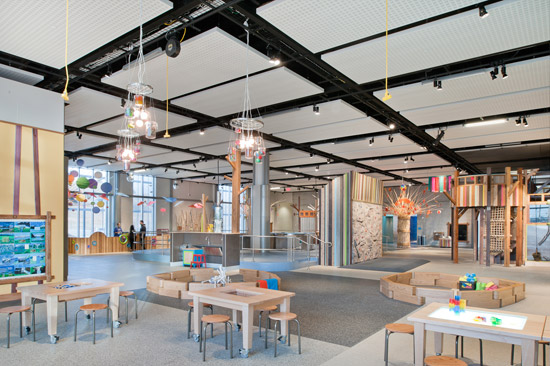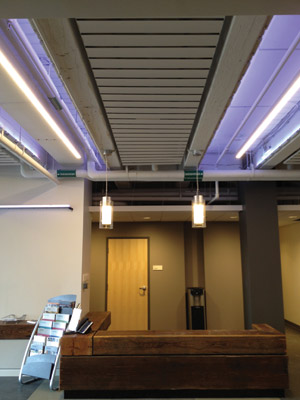Architects Warm to Chilled Ceilings
Radiant Systems in Boston’s Building Technology Showcase |
||
Fraunhofer’s Building Technology Showcase (BTS) represents the future of sustainable design. Completed in 2013 in Boston’s fast-growing innovation district, the BTS is a deep energy retrofit of a 100-year-old building that serves as a living laboratory for R&D of advanced sustainable energy technologies. Radiant technology figures significantly in the building’s energy-saving strategy. In the lobby reception area and gallery, chilled sails are installed in the ceiling between the support struts. Displacement ventilation is installed along the wall. The controls setup runs displacement as the first stage of cooling, and uses chilled sails as a second stage of cooling under normal operating conditions. The chilled sails rely on the displacement system to provide ventilation and satisfy latent loads, which results in a greatly reduced supply air volume requirement, making this hybrid solution extremely energy efficient when compared to a traditional all-air system. The entire central section of the sixth floor is dedicated to the BEEG Workshop, where radiant panels complement the natural ventilation system. When appropriate exterior and interior temperature and humidity conditions exist, the system will satisfy occupied space conditions using the natural ventilation system. The system also provides supplemental cooling when necessary using the radiant panels. When the occupied space conditions cannot be maintained using natural ventilation and radiant panels, the mode of operation changes to mechanical cooling using fan coils. |
Design Considerations
A number of functional and aesthetic issues should be considered to properly specify radiant heating and cooling systems.
Applications
Chilled ceilings and sails can be an asset to a wide range of building types, including, but not limited to:
• Office spaces
• Schools
• Post-secondary educational facilities
• Healthcare
 |
Radiant panels and chilled sails improve thermal comfort while providing energy efficiency and contributing to LEED designation. Here, they enhance the architectural design at TELUS Spark: the New Science Centre. Photo courtesy of Price Industries |
In addition to energy savings, radiant heating and cooling systems offer a customized aesthetic and potential reduction in the amount of plenum and shaft space required for the mechanical service, translating into shorter floor-to-floor construction or higher ceilings. In most cases, owners will trend towards an integrated, unique approach to the chilled ceiling that can differentiate the building from others, as well as potentially reduce construction time and cost by integrating services and reducing the amount of time spent installing each disparate system. In the extreme cases, significant economy has been seen by installing pre-fabricated integrated ceilings on site, where the lighting, acoustical treatment, mechanical cooling and ventilation, as well as the ceiling itself are all installed at once.
It is worth noting that there are several areas in a building where humidity can be difficult to control, such as lobby areas and locations of egress. These areas may see a significant short-term humidity load if the entrances are not isolated in some way (revolving doors or vestibules). In these areas, a choice of a complementary technology such as fan coil units or displacement ventilation is ideal. Other applications may have high airflow/ventilation requirements, such as an exhaust driven lab. Most of the benefit provided by the hydronic system is linked to the reduction in supply air flow. As such, these applications may not see sufficient benefit to justify the addition of the hydronic circulation system, making them unlikely to be good candidates in these situations.
Architectural applications. The cooling capacity and unique design of chilled ceilings make them an excellent alternative to panel systems, particularly in applications that have an architectural focus. Typical applications of chilled sails and customized radiant panels include offices, meeting/conference rooms, theaters, studios, lobbies/foyers, waiting areas, or any areas where radiant panel use is appropriate. Chilled sails can either be concealed or exposed. Concealed chilled sails with a standard black finish remain undetected from the room side when mounted above perforated ceiling tiles. Exposed chilled sails designed for architectural appeal are typically installed in interior spaces as a cloud ceiling, in a suspended ceiling or in a T-bar application with a standard white finish. They can also be installed along a wall in a surface-mounted application, or placed around utilities such as lights, sprinklers, air outlets, and the like.










